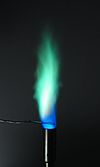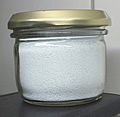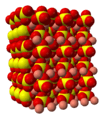Copper(II) sulfate facts for kids
| Copper(II) sulfate | |
|---|---|
 |
|
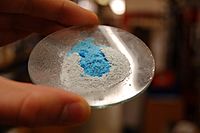 |
|
| General | |
| Systematic name | copper(II) sulfate |
| Other names | cupric sulfate, copper sulfate, chalcanthite, blue vitriol, bluestone |
| Molecular formula | CuSO4 |
| Molar mass | 143.61 g/mol |
| Appearance | blue solid crystals when hydrated, white solid when anhydrous |
| CAS number | 7758-98-7 |
| Properties | |
| Density and phase | 3.603 g/cm³ (anhydrous), 2.284 g/cm³ (hydrated) |
| Solubility in water | 31.6 g/100 ml (0°C) |
| Solubility in ethanol | insoluble, both forms |
| Solubility in methanol | hydrate is soluble |
| Melting point | 150°C (423 K) dehydrates, 650°C decomp. |
| Structure | |
| Coordination geometry |
octahedral |
| Crystal structure | triclinic |
| Hazards | |
| MSDS | MSDS |
| Main hazards | (Xn) Harmful (Xi) Irritant (N) Dangerous for the environment |
| NFPA 704 | |
| R/S statement | R: R22, R36/38, R50/53 S: S2, S22, S60, S61 |
| Related compounds | |
| Other anions | Copper(II) chloride, Copper(II) oxide |
| Other cations | Sodium sulfate, Manganese sulfate, Iron(II) sulfate |
| Except where noted otherwise, data are given for materials in their standard state (at 25 °C, 100 kPa) Disclaimer |
|
Copper(II) sulfate, also known as cupric sulfate or bluestone, is a common chemical compound. Its chemical formula is CuSO4. It contains copper and sulfate ions. This compound is usually a blue solid. It can be used to kill fungi and to make copper metal purer. You might see it in chemistry sets and during science lessons at school.
Contents
What is Copper(II) Sulfate?
Physical Features
Copper(II) sulfate looks blue when it has water molecules attached to it. We call this "hydrated." When it doesn't have water, it's a whitish solid, and we call it "anhydrous."
Usually, the blue form has five water molecules connected to each copper sulfate molecule. You can remove this water by heating it up. If you add water back, it turns blue again. It can even absorb water from the air and become hydrated.
How it Reacts
Copper(II) sulfate is a weak oxidizing agent. This means it can take electrons from other substances.
It reacts with most metals to form copper and a metal sulfate. For example, if you put iron in copper sulfate solution, you get copper metal and iron(II) sulfate:
- Fe + CuSO4 → FeSO4 + Cu
It also reacts with substances like sodium hydroxide or potassium hydroxide. This reaction creates copper(II) hydroxide:
- CuSO4 + 2 NaOH → Cu(OH)2 + Na2SO4
When it reacts with sodium carbonate, it forms copper(II) carbonate:
- CuSO4 + Na2CO3 → CuCO3 + Na2SO4
If you mix it with ammonia, it makes a dark blue solution. This solution is so strong it can even dissolve cotton fibers.
- CuSO4 + 4 NH3 → Cu(NH3)4SO4
When heated to very high temperatures, copper(II) sulfate breaks down. It turns into copper(II) oxide and sulfur trioxide:
- CuSO4 → CuO + SO3
Like all copper compounds, it creates a blue-green color when heated in a flame. This is called a flame test.
Where is it Found?
Copper(II) sulfate can be found naturally as a mineral called chalcanthite. This mineral is easily dissolved by water, so it's mostly found in dry places.
Chalcanthite is usually blue or green. When it's exposed to air, its bright blue color can fade. Some mineral collectors like to find it.
How is it Made?
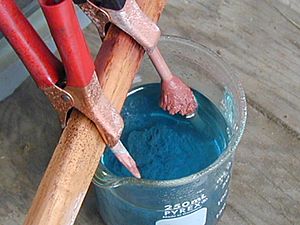
Making copper sulfate in a small lab isn't common because it's easier to buy it. However, there are ways to make it:
- You can make it using electrolysis. This involves passing electricity through a solution of sulfuric acid with copper electrodes. This process also produces hydrogen gas.
- Cu + H2SO4 → CuSO4 + H2
- It can also be made by reacting copper(II) oxide, copper(II) hydroxide, or copper(II) carbonate with sulfuric acid:
- CuO + H2SO4 → H2O + CuSO4
- Cu(OH)2 + H2SO4 → 2 H2O + CuSO4
- CuCO3 + H2SO4 → H2O + CuSO4 + CO2
- Another way is to add copper to hot, concentrated sulfuric acid:
- Cu + 2H2SO4 → CuSO4 + H2O + SO2
- You can also make it by reacting copper with a mix of nitric acid and sulfuric acid.
What is it Used For?
Copper(II) sulfate is a very useful copper compound with many different applications:
- Killing Pests: It can be used to kill algae and fungi. Sometimes, fungi can become resistant to it, meaning it no longer works. It can also be mixed with lime to create a similar fungus killer.
- Fish Health: It's used to treat aquarium fish for certain infections.
- Detecting Sugars: In chemistry, it helps detect certain sugars. When a sugar reduces it, copper(II) sulfate changes into red copper(I) oxide.
- Chemistry Experiments: It's often found in chemistry sets. It's great for showing a reaction called a "displacement reaction." In this reaction, one metal replaces the copper in copper sulfate, creating new copper metal and a different metal sulfate.
- Hydrated vs. Anhydrous: It's also used to show the difference between "hydrated" (with water) and "anhydrous" (without water) chemicals.
- Purifying Copper: Copper(II) sulfate is used to make copper metal purer. Here's how it works:
- A thin piece of pure copper and a thicker, impure piece of copper are placed in a copper sulfate solution.
- The thin, pure copper is connected to the negative side of a power source (the cathode).
- The thick, impure copper is connected to the positive side (the anode).
- When electricity flows, the copper from the impure piece dissolves into the solution. Then, pure copper from the solution sticks onto the thin, pure copper piece. Any unwanted substances (impurities) from the thick piece fall to the bottom.
Safety Information
Copper sulfate can be harmful to humans if not handled carefully. It is very harmful to fish.
- Skin and Eyes: It can irritate your skin and eyes. Always wash your hands after touching it and avoid getting it in your eyes.
- If Swallowed: If someone accidentally swallows it, it can cause nausea (feeling sick to your stomach). It often makes a person throw up naturally. However, if too much is swallowed and stays in the stomach, it can cause serious health problems. It is important to never taste or eat copper sulfate.
Related pages
Images for kids
See also
 In Spanish: Sulfato de cobre(II) para niños
In Spanish: Sulfato de cobre(II) para niños



